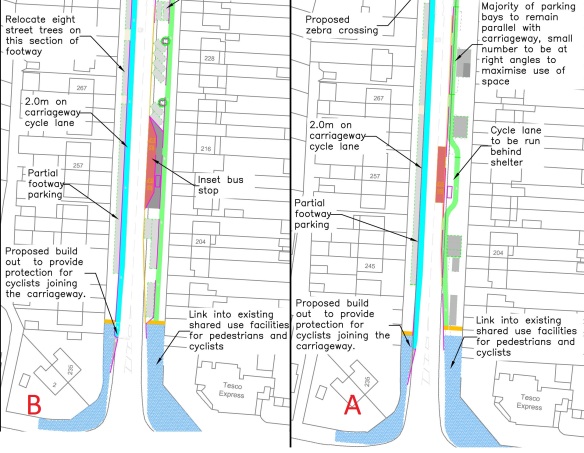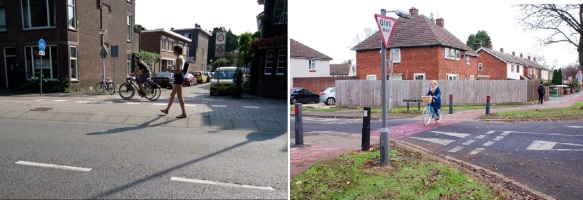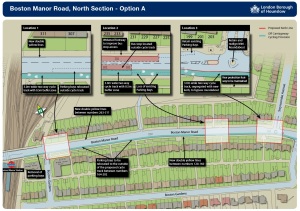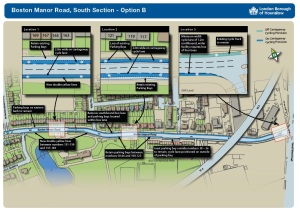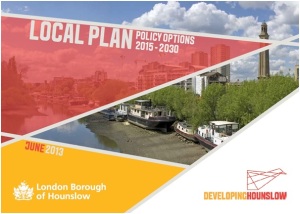Unless the Cycling Vision is applied to Chiswick’s A-roads, they will continue to be polluted barriers to cycling rather than permeable routes. Junction designs should include cycling infrastructure that makes riding a bike feel safe.
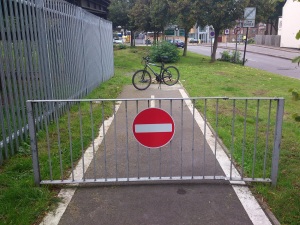
How does Transport for London decide what infrastructure cyclists in Chiswick get?
Transport for London are well known for coordinating bus and underground services. Transport for London also control the layout of a many of London’s main roads, including the Great West Road (A4) and Chertsey Road (A316). What is much less well known is the way Transport for London’s rules and modelling of traffic flow overwhelmingly favour people in motor vehicles over people walking or cycling on the roads that Transport for London controls and those controlled by the local boroughs.

Transport for London is legally obliged to ensure effective movement of traffic whether on foot, bike or anything else. But the different elements of traffic are not valued equally…
In Transport for London’s traffic modelling guidance a person on a bike is explicitly given a fifth of the value of a person in a car. So when Transport for London say they want to smooth the traffic flow, people on bikes are already discounted as the valuation is already biased against them. As a result, Transport for London have a history of only providing cycling infrastructure that does not reduce road capacity for motor vehicles which has typically been low quality cycling infrastructure. The fact that a person on a bike is more vulnerable than people in vehicles is not taken into account. De-valuing cycling is also contrary to NICE guidance that active travel should be prioritised over non active travel.
(Notably a bus that could easily be carrying 50 or more people is only given the value of two single occupant cars, so TfL roads don’t work well for those travelling by bus either).
How does this affect the roads around Chiswick?
In January 2012, Transport for London proposed changes to Sutton Court Road with the objective in their words to “improve facilities for cyclists and pedestrians and improve road safety for everyone who uses the A4 Ellesmere Road/Cedars Road junction with Sutton Court Road”.

plan for Sutton Court Road/A4 junction proposed by Transport for London in 2012
With this objective, Hounslow Cycling could have reasonably expected cycle lanes of reasonable width, advance stop lines and a robust mechanism of giving cyclists a head start so they have a strong road position are visible to motorists, especially on the uphill climb crossing the A4 northwards.
The London Cycling Campaign has been promoting cycling infrastructure of the standard seen in Denmark and the Netherlands in its Go Dutch campaign. The London Cycling Campaign push for junction designs where the cyclists travelling straight on are not put into conflict with motorists wanting to turn left and where there is sufficient space for those walking and cycling that there aren’t conflicts between them.
Instead of proposing high quality cycling infrastructure, no doubt because of the imperative of smoothing the [motor] traffic flow, the plans for the Sutton Court junction included a left-turn-only lane on its uphill approach. Transport for London’s own London Cycling Design Standards advise that “to reduce the distance where cyclists are vulnerable, the [left turn] slip lanes should be removed completely by re-configuring the junction or, where this is not feasible, reduced to the minimum required by reducing the taper” Under TfL’s models what is “feasible” seems to depend more on smoothing the [motor] traffic flow than giving a strong feeling of safety to cycle routes.
The result of TfL’s plans would have been to push people on bikes onto the small pedestrian crossing islands with likely increases in conflicts with pedestrians and with up to six crossings to make, a discouragingly slow journey (smoothing the cycling flow it aint). By the way, to their credit, Hounslow Council did not support Transport for London’s plans.
The response Hounslow Cycling received from Transport for London after asking for a better cycling infrastructure plan at Sutton Court Road’s junction with the A4:
“As part of our continued drive to reduce the number of people hurt on our roads this junction was identified as having a specific right turning problem from Sutton Court Road (north) onto the A4 (west). This is a difficult manoeuvre … as a result a number of collisions have occurred. The left turn only lane on Sutton Court Road (south) is proposed in order to make it easier for vehicles to make this right turning movement by reducing the number of lanes of traffic they have to cross. In addition, cyclists travelling northbound from the outside lane will be more visible to these right turning vehicles because they will only have to identify an appropriate gap in one lane of traffic rather than two at present. Finally, the majority of vehicles travelling along Sutton Court Road south to north through the junction do so from the outside lane; particularly in the morning and evening peaks when 98% and 87% of vehicles respectively do so. Therefore the majority of vehicles in the inside lane are turning left and as a result cyclists are more likely to come into conflict with turning traffic if they travel through the junction in this lane. The designs for this scheme are not finalised and, as explained in the consultation response, the scheme will be going through our Junction Review process, which will ensure that we are doing all that we feasibly can to improve facilities for cyclists and other vulnerable road users.”
The Junction Review process is a key part of Boris’s Cycling Vision, so perhaps that is why Hounslow Cycling has recently heard that Transport for London are re-evaluating their proposals; developing an amended scheme with a further consultation.
The A4 is a major barrier to cycling north-south. While Grove Park primary school and Strand on the Green Junior School have made excellent progress at promoting cycling to school by their students, those families living north of the A4 most likely find the prospect of cycling to these schools daunting and uninviting. Hounslow Council have also drawn up plans for cycle superhighway 9 to pass along Chiswick High Road, so it is vital that the A4 does not create a barrier to Chiswick cyclists reaching the cycle superhighway.
Will Boris’s Cycling Vision bring the solution?
The Cycling Vision promises that:
“London’s streets and spaces will become places where cyclists feel they belong and are safe. Spending on the junction review will be significantly increased, and it will be completely recast to prioritise major and substantial improvements to the worst junctions, though other junctions will still be tackled.”
In the Cycling Vision document, Transport for London claim to be refining their sophisticated traffic modelling systems to take better account of cyclists. With the benefit of these, all future road and junction builds or redevelopments and transport schemes on the roads controlled by TfL will be subjected to improved (but unspecified) forms of cycling safety assessment prior to approval. Boris’s cycling vision promises short stretches of segregated bike lane, where possible, just before busy traffic lights so cyclists can get through stationary traffic to reach the ASL at the front.
The original plan for the review of London’s 100 junctions most in need of a safety review included Sutton Court Road’s junction with the A4. Transport for London have since said that the number of junctions they will address has greatly reduced and we will have to wait and see whether the new designs proposed for Sutton Court Road will make it a place where cyclists feel they belong and are safe. We know that junctions at Blackfriars, Vauxhall, Tower, Aldgate, Swiss Cottage and Elephant & Castle, are being focused on and that improvements at these places will include widening to allow more space for cyclists, creating more segregated cycle lanes and installing innovative ‘early-start’ traffic signals to allow cyclists to move onto the junction ahead of other traffic.
Hounslow Cycling will demand infrastructure of no lesser standard in Chiswick.
So, apart from Sutton Court Road, where else in Chiswick can you cross the A4? Well you could use the subway at Cedars Road, or how about Hogarth Roundabout?
There has been much confusion over the hideous cycle lane that almost crosses Hogarth Roundabout. Transport for London had proposed that the cycle path cross Dorchester Grove’s two lane approach to the Hogarth roundabout, on a curve, very close to the signalised junction, but without signals, thus placing cyclists into considerable potential danger. Both Hounslow Council and Hounslow Cycling proposed that the only way that these cycle lanes could be safe would be with traffic light controlled crossings for cyclists. Transport for London have repeatedly refused to install traffic light crossings claiming that:
“It is possible to introduce a signalised crossing on this arm [crossing across Dorchester Grove to link the currently closed cycle track under the flyover with the footway towards Chiswick Roundabout] but this would cause a significant increase in queue lengths around the roundabout and on all approach arms which is unlikely to be acceptable to local residents or users of the A4 and A316. There would also be an increase in traffic on local roads as vehicles seek alternative routes to avoid the junction and again this would be to the detriment of local residents including cyclists using these quieter routes.”
“The design work for the informal crossing across Dorchester Grove is ongoing and we expect to have a draft design ready to be road safety audited within a month after which we will consult with the council. Once we have a design that has been agreed with the council we will consult with other local stakeholders”
Informal crossings across very busy roads do not feature in Boris’s Cycling Vision. Nor should they as they do not give people on bikes a safe route nor do they provide the ‘calm junctions’ demanded by the London Cycling Campaign’s Go Dutch design criteria.
Along with Chiswick residents, Hounslow Cycling is waiting to see what plans Transport for London will produce next. At every step Hounslow Cycling will urge Transport for London to install high quality cycling infrastructure and to bring the Cycling Vision to Chiswick.
Transport for London is under the control of the London Assembly, so if you would like to find out more about the decisions being made, you can ask the Assembly Members that represent you: Tony Arbour ,Darren Johnson, Murad Qureshi ,Caroline Pidgeon , Gareth Bacon , Fiona Twycross , Andrew Boff , Tom Copley, Victoria Borwick, Jenny Jones , Nicky Gavron , Stephen Knight .
You can contact Hounslow Cycling on Twitter or Facebook to share your views.
Postscript
Thank you to Rachel Aldred and many others who have highlighted the fact that Passenger Car Units can be used to highlight one of the benefits of cycling and cycling infrastructure: a given area of road can hold a greater number of people if they cycle than if they drive, just as a given area of road can hold more people if they travel by bus rather than drive. Most people don’t cycle unless the road design includes a clear space for cycling.
Rachel suggests that road designers should find good ways of estimating and modelling how many people are put off cycling or prevented from cycling by the current inadequate level of cycling infrastructure; people who would cycle if cycling infrastructure was present. The smaller road space required for these people would make the roads more efficient.

